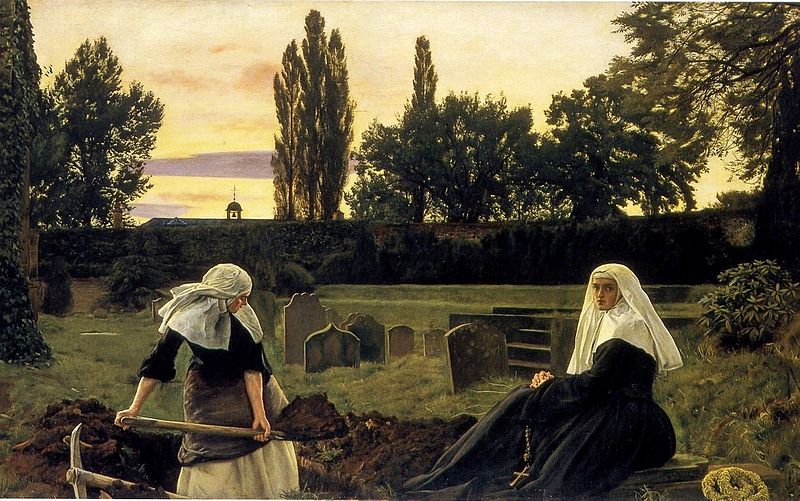The Vale of Rest, a painting by John Everett Millais, 1858-59
No quality in art and fiction writing is more elusive and perplexing than sincerity.
No cemetery is quieter than one where nuns lie buried.
No school memories are richer or more compelling than those the Sisters left for us.
Insincerity ought to be easy to detect, there being so much of it close at hand in the form of self-deception and self-promotion. It is not easy, though. I first saw its ghostly presence years ago under the watchful eyes of Sister Almeda, SSND. I hear her saying, “Don’t rationalize, James. Don’t make things up!” It was not the first time she said it to me and to others. She would have embroidered those words on a school patrol flag lowered down over a street named Self-serving Excuses.
This is tough love, Sister Almeda, especially for school children and writers and readers of fiction. After all, what do kids and novelists do but make things up? What do readers want these days but pleasure and escape?
It is almost too easy for a novelist to deceive. When confronted with a few doozies, Dan Brown reminded his critics again and again that The Da Vinci Code was fiction. No matter that readers by the thousands went to Paris and London expecting to see what he saw. More than a few must have scratched their heads as they searched for that huge Opus Dei complex under construction in New York City. For Dan Brown, fact and fiction are as enigmatic as Mona Lisa’s smile.
Sister Almeda would have shaken a finger in his face.
If truth and honesty are not ever-present in fiction, if all that matters is making things up for the sake of selling books, what is wrong with an entire story being a pack of lies? Brown is a talented writer and an accomplished storyteller. His novel is far from a pack of lies, but honesty is especially called for when stories are wrapped in appearances of competent scholarship blurring the line between fact and fiction. (See The Da Vinci Hoax, Ignatius Press 2004).
The Da Vinci Code, Fifty Shades of Grey, and other ‘blockbuster’ novels often hyped as mesmerizing are just that, the works of modern day Svengalis. Anyone reading George Bousant du Maurier’s Trilby, a nineteenth-century best seller, will know that du Maurier’s Svengali employed a mixture of science, superstition, gullibility, and guile to mesmerize his victim. Svengali was anything but sincere. Brown and E. L. James are not evil geniuses, but they know how to cast spells, and they both strike me as disingenuous.
I suppose there are many ways to distinguish sincerely written novels from those playing tricks on the reader. Certainly the latter seem more at home in the flotsam and jetsam of screaming hype—Mesmerizing! Riveting! Sexy! Five Star! Some so touted seem fit for pitching by the carnival barker on an old-fashioned midway, the sort our parents cautioned us to avoid. Imagine that.
Which novels give us hope and while entertaining, also uplift and inspire? Which ones would you feel comfortable reading near the grave of Sister Almeda or maybe the grave of your mother?
To judge from the most hyped ones, apparently it is good to be thrown into a hypnotic trance by something that can be read or watched without thinking. This from a Fifty Shades promo:
Erotic, amusing, and deeply moving, the Fifty Shades Trilogy is a tale that will obsess you, possess you, and stay with you forever.
Apparently, it’s okay to forget what you saw and where you were when you snapped out of it, except you feel vaguely ashamed and worried that you might have made a fool of yourself while you were under a spell and out like a light, or that you might have sold piecemeal a bit of your soul for something less than twenty pieces of silver.
As school kids called to account after a playground dustup, we attempted our own versions of self-serving and diverting blockbusters. Sister Almeda would have accused us of mesmerizing razzmatazz, the noisy distraction concocted to deflect criticism and justify bad conduct. In the world we students shared with her, every report card gave us a grade for conduct. Also imagine that.
With respect to details and intentions, hidden or otherwise, storytellers—whether kids caught rationalizing, or novelists trying to sell books—see themselves as magicians. Magic artists expect to be believed. The way they present it is the way it has to be; do not question the show. This is especially true when it comes to fantasy, science fiction, and stories far removed from anything a likely reader would know about firsthand.
The rabbit pulled from a magician’s hat has become the inevitable helicopter and bedroom scene appearing in fiction and film when all seems lost, especially the reader’s interest.
Teachers hear such stories from students all the time. They have watched paper airplanes whiz by from nowhere. I can well imagine that Sister Almeda, in her distant younger days, caught more than one rascal red-handed. Young Dan Brown and E. L. James would not have gotten away with any more than we did back then.
Mesmerizing novels resemble the entertainments Mephistopheles conjures to divert Faustus. As midnight and the end approach, Faustus is beguiled with a pageant of the Seven Deadly Sins. Mephistopheles wants Faustus to accept the vision as sincere, a real-life sideshow he missed all along. Faustus must not see the through the veil: the ‘face that launched a thousand ships’ was not Helen of Troy, but a devil in disguise. And by all means, don’t hang around afterward to see what was actually behind the curtain. For Faustus, the jig is up.
It was not exactly such things that Sister Almeda had in mind when she chided me and others. It was instead, in our farm kid lingo, the proverbial silk purse from a sow’s ear. All along our stories had about them the whiff of self-deception, and the telltale signs of convenient history, cherry picked. Sister saw it for what it was, a type of dishonesty, a failure to be true-to-self and true to others. We were not ‘just kidding’, as we sometimes claimed once the jig was up.
How can a novelist or any artist say, ‘I was just kidding’?
 Caravaggio’s The Denial of Saint Peter comes to mind. It depicts sincerity and insincerity, betrayal and self-betrayal in the same heated instant. Saint Peter’s denial is the beautiful story of guilt and almost instantaneous remorse and Christ’s forgiveness. Caravaggio’s painting is a novel in a single picture. Saint Peter need not have a Sister Almeda around to remind him that it was his true self he also betrayed. You can almost hear the cock crow.
Caravaggio’s The Denial of Saint Peter comes to mind. It depicts sincerity and insincerity, betrayal and self-betrayal in the same heated instant. Saint Peter’s denial is the beautiful story of guilt and almost instantaneous remorse and Christ’s forgiveness. Caravaggio’s painting is a novel in a single picture. Saint Peter need not have a Sister Almeda around to remind him that it was his true self he also betrayed. You can almost hear the cock crow.
Another painting is John Everett Millais’ The Vale of Rest, with two nuns in a churchyard digging a grave. A lot if silly things have been said about this painting, not unlike some of silliness spilled over today’s blockbusters. Still, a great painting can be a lesson in reading: when you do not want to turn the page, but instead want to linger, you are in the presence of great art, framed and hung before you. Each page of a genuine masterpiece is a portrait or a landscape. You are in another sort of trance, the spell cast by something worth your time.
Millais’ Vale of Rest brings me back to Sister Almeda and so many others at rest in the School Sisters of Notre Dame Cemetery on Good Counsel Hill in Mankato, Minnesota. Attend any school reunion, watch a few movies or TV shows, and you will hear and see a lot of silly things about nuns too. Whatever else Millais intended to say, he never meant it for laughs: the painting is as serious as life and death on earth.
It’s quiet these days at Good Counsel Cemetery. Now and then a few of us old students may happen by. I like to think so.
As far as I know, Sister Almeda never taught art history, never painted, and never tried to write a novel, but after all these years her words still ring. “Don’t rationalize, James. Don’t make things up!” She was right even without novels in mind: it is not enough for a fiction writer to make things up; there has to be truth in it and honesty, both with self and readers.
Lucky thing for humankind that the Creator seems disinclined to play writer just making things up. Using the same computer commands we employ, seduced by the same ambitions, God might have us sleep in one novel, and awaken us next morning in an entirely different one. Don’t look under the bed.
Some novels are like brush fires in high winds; a great novel is a candle in the window. The one is all about hot air; the other about sincerity.







John
August 21, 2015 at 11:27 pm
Reading this James, I couldn’t help thinking of Flannery O Conner. Now there’s some truth in fiction if there ever was.
carleolson
August 25, 2015 at 8:37 pm
Thanks, James, for the shout out for “The Da Vinci Hoax”. I disagree, however, with the statement that Dan Brown is “talented writer and an accomplished storyteller.” No, not true. He’s a very poor writer (Tim LaHaye is worse, but that’s not saying much). I once forced a good friend, a very well-read and literate man, read the first five pages of “The Da Vinci Code”. He made it through page 3, then exclaimed: “This a pile of *****!!” Yep. And that’s probably an insult to “*****”. Secondly, yes, “The Da Vinci Code” really is a pack of lies. I estimate–in all seriousness–that well over 90% of the historical and factual claims made in the novel are either partially or completely incorrect. It’s astounding. The appeal of the novel was secret knowledge and pseudo-sophisticated and anti-Catholicism. There was no art, no sincerity, no desire to inspire or dig deep. And it sold over 60 million copies. Read it and swear and weep!